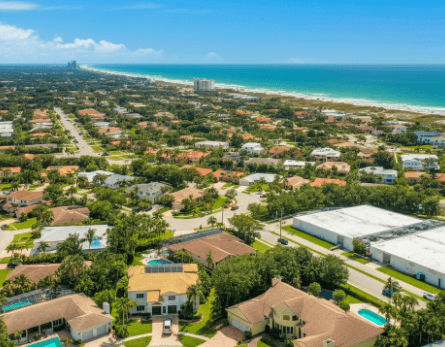Welcome to our exploration of the “Typical Size Lots in Florida,” where we demystify the space you can expect when purchasing property in the Sunshine State. Whether you’re dreaming of building your own home, investing in real estate, or simply curious about the lay of the land, understanding the Typical Size Lots in Florida is crucial. Join us as we venture into the various aspects that influence lot sizes, from coastal areas to the inland, providing insights and guidance for prospective homeowners and investors alike.
Steve Daria and Joleigh, seasoned real estate investors, emphasize the importance of understanding lot sizes in Florida’s diverse real estate market. They point out that while waterfront properties often boast larger lot sizes to accommodate amenities like boat docks, urban areas offer smaller, more compact lots. A deep comprehension of lot size dynamics is essential for making well-informed investment choices in Florida.
The Lay of the Land: A Primer on Florida’s Real Estate Terrain
Before we discuss the typical size lots in Florida, it’s crucial to grasp Florida’s broader real estate landscape.
The state’s unique topography, which encompasses urban areas and vast, undeveloped spaces, leads to various lot sizes to accommodate different lifestyles and developmental plans.
Florida real estate is often characterized by various zoning codes dictating permissible land uses and lot divisions.

These codes ensure that new developments and land use changes are consistent with the comprehensive land use plan supporting the community’s growth vision.
In Florida, zoning can range from agricultural, with larger plots of land, to heavily urban, with smaller, denser lots.
Size by Side: Typical Size Lots in Florida
The typical size lots in Florida can be diverse, influenced by many factors such as location, community planning, and the type of development.
From quaint residential parcels to expansive acreages, here’s a snapshot of the size ranges commonly found in the state:
Urban Residential Lots
Urban dwelling often means living with a smaller footprint. In major metropolitan areas like Miami, Tampa, and Orlando, residential lots typically range from 5,000 to 10,000 square feet. These sizes cater to the compact city lifestyle while affording room for a modest yard or outdoor space.
Suburban Homesteads
Head out of the city centers into the suburbs and discover more elbow room. Suburban lots generally occupy between 8,000 and 15,000 square feet, providing more space for privacy and outdoor activities while maintaining the community feel of suburban life.
Rural Acreages
For those looking to spread out, Florida’s rural areas offer acreages and lots that go well beyond the suburban scale.
Here, you’ll find typical size lots in Florida that can be measured in acres, often ranging from 1 to 10 acres or more. These lots are suitable for various uses, from ranches and farmland to personal estates.
Waterfront Properties
Florida is synonymous with its extensive waterfront properties, which can significantly alter the paradigm of lot sizes.
These lots, whether on the ocean or a coastal waterway, can range from a few hundred square feet to several acres due to their premium location and the priority given to water access and views.
Get Started: Get Your Cash Offer Below…
We are direct land buyers. There are no commissions or fees and no obligation whatsoever. Start below by sharing where your property is and where we can send your offer…
The Impact of Lot Size on Property Value
The size of the lot is a significant contributor to a property’s overall value. Larger lots typically command a higher price, reflecting the desire for more privacy and space that many homebuyers seek.
A more considerable lot also offers more flexibility for future expansions, such as adding a pool, guesthouse, or outdoor amenities.
Smaller lots are often an attractive option for first-time homebuyers or urban dwellers, as they are more affordable and require less maintenance.
Zoning Regulations and Lot Sizes
Understanding typical size lots in Florida goes hand-in-hand with comprehending zoning regulations.
Zoning in Florida is a crucial component of land-use planning and property development, defining how land can be used and developed.
Lot sizes play a direct role in the following zoning aspects:
Setbacks
Setback regulations determine how close a structure can be to the property line. Lot size often dictates these distances, protecting the aesthetic appeal and ensuring safe community conditions.
Density
Zoning codes also control the density of buildings within a given lot size. For instance, family dwellings may be limited to one for every 5,000 square feet in an area zoned for low density, while an area zoned for high density might allow for a multi-level apartment complex based on the same size lot.
Use
Zoning also guides the use of property, which is influenced by lot size. For example, agricultural zoning usually requires larger lot sizes to accommodate space for cultivating crops or raising livestock, while a commercial lot will have its specific requirements.
Purchasing the Right Size Lot in Florida
Whether you’re buying land to build a custom home, start a business, or add a property to your investment portfolio, selecting the correct lot size is critical.
Consider Current and Future Needs
Evaluate your needs and plans for the property. Do you require a large yard for your family, green space for a community garden, or a significant area for commercial development?
Considering immediate and potential future uses will help you determine the appropriate lot size.
Get to Know the Neighborhood
Research the neighborhood to get a feel for the typical size lots in Florida and how they align with your preferences and lifestyle.
If you’re choosing a residential lot, ensure it corresponds with the size and style of homes in the area to avoid resale difficulties.
Consult with Professionals
Work with real estate agents, land planners, and attorneys experienced in Florida real estate to guide you through the complexities.
These professionals can help you interpret zoning codes, assess the property’s value, and negotiate the best terms for your purchase.

Check for Utilities and Access
A more considerable lot in a remote area may seem idyllic. Still, if it lacks access to utilities like water, electricity, and sewer or is challenging to reach, it can present significant challenges and costs for development. Confirm that the lot’s size aligns with services and that ease of access is needed.
Review Financing Options
Your choice of lot size can impact your financing options. Larger lots may require a jumbo loan, while smaller lots could be financed with conventional loans.
Consider your financial situation and how the lot size will influence your mortgage rates and terms.
Developing on Different Lot Sizes
The development of many different sizes requires unique considerations and approaches.
Large Lots
Developing on a large lot allows for ample creativity and freedom in design, landscaping, and functionality.
You have the space to create expansive homes, intricate gardens, and diverse amenities, making your vision come to life.
Small Lots
Building on a compact lot in an urban setting requires efficient use of limited space. Small lot development often involves:
- Vertical construction is innovative.
- Intelligent design that maximizes every inch.
- Attention to detail can make the property stand out despite its smaller size.
The Ever-Evolving Lot Size Trends
Lot size trends continually shift in response to economic, environmental, and lifestyle dynamics. In Florida, the surge of urban growth has triggered a trend towards a more significant number of smaller lots, especially in mixed-use districts and transit-oriented developments.
Conversely, there’s an enduring demand for estates and properties with oversized lots, particularly those with high-quality natural features such as reserves, gardens, and waterfront access.
Ensuring a Smooth Selling Process
If you’re on the selling end, your understanding of lot sizes can significantly impact your property’s marketability.
Highlight the Lot’s Features
When listing your property, emphasize the unique benefits of the lot size. Whether it’s the spaciousness of a large lot, the convenience of a modest one, or the rare chance to acquire waterfront property, these attributes enhance the selling points and attract potential buyers.
Be Clear on Zoning Information
Ensure that the zoning information for your lot is clear and readily available to prospective buyers.
Understanding permissible uses and potential limitations can ease the buyer’s decision-making process and streamline the sale.
Know the Comps
Research recent sales in your area to determine how lot size influences the selling price. Compare properties with similar lot sizes, amenities, and locations to set a competitive price reflecting market value.
Provide Development Ideas
Consider providing development ideas or plans for undeveloped lots to spark buyer interest. Suggestions on how best to utilize the space can help buyers see the lot’s value more clearly.
Be Open to Negotiation
Be prepared for negotiations when selling land. The right lot size could be the deciding factor in whether a potential buyer will accept your terms.
Conclusion
Choosing the correct lot size in Florida is a multifaceted puzzle, with pieces that interact to create your ideal real estate panorama. While size is one aspect of many to consider, its importance cannot be overstated. By understanding the implications of lot sizes on property value, zoning regulations, and development potential, you can carve out your space in the Florida real estate market with confidence and foresight.
In a land as diverse as Florida, ensuring that the lot is sized right for your immediate and future needs is a pivotal step toward a successful and fulfilling real estate venture. Whether you’re scaling down for a cozy inland bungalow or up for an expansive waterfront estate, the Sunshine State’s varied lot sizes offer an array of opportunities for those who know how to read the map.
**NOTICE: Please note that the content presented in this post is intended solely for informational and educational purposes. It should not be construed as legal or financial advice or relied upon as a replacement for consultation with a qualified attorney or CPA. For specific guidance on legal or financial matters, readers are encouraged to seek professional assistance from an attorney, CPA, or other appropriate professional regarding the subject matter.
